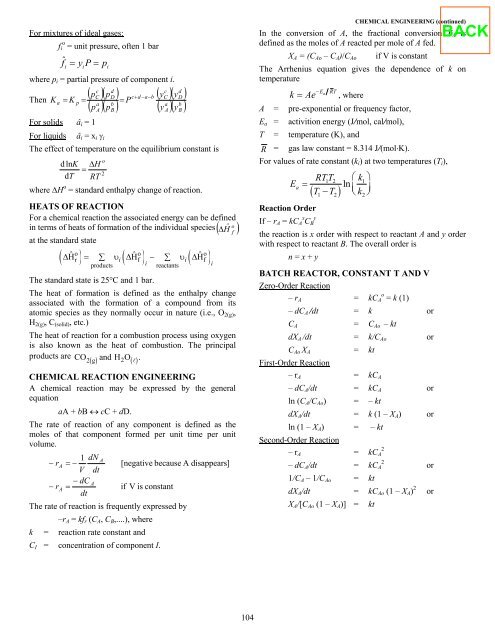fundamentals of engineering supplied-reference handbook - Ventech!
fundamentals of engineering supplied-reference handbook - Ventech!
fundamentals of engineering supplied-reference handbook - Ventech!
Create successful ePaper yourself
Turn your PDF publications into a flip-book with our unique Google optimized e-Paper software.
For mixtures <strong>of</strong> ideal gases:<br />
fi o = unit pressure, <strong>of</strong>ten 1 bar<br />
f ˆ = y P = p<br />
i<br />
i<br />
where pi = partial pressure <strong>of</strong> component i.<br />
c d ( pC<br />
)( pD<br />
)<br />
Then K a = K p =<br />
a b ( p )( p )<br />
For solids âi = 1<br />
A<br />
i<br />
B<br />
= P<br />
c+<br />
d −a−b<br />
c d ( yC<br />
)( yD<br />
)<br />
a b ( y )( y )<br />
For liquids âi = xi γi<br />
The effect <strong>of</strong> temperature on the equilibrium constant is<br />
d lnK<br />
∆H<br />
=<br />
dT<br />
RT<br />
o<br />
2<br />
where ∆H o = standard enthalpy change <strong>of</strong> reaction.<br />
HEATS OF REACTION<br />
For a chemical reaction the associated energy can be defined<br />
in terms <strong>of</strong> heats <strong>of</strong> formation <strong>of</strong> the individual species o<br />
H f<br />
at the standard state<br />
ˆ o ˆ o ˆ o<br />
∆ H = ∑ υ ∆H − ∑ υ ∆H<br />
ˆ ∆<br />
( r ) i( f ) i(<br />
f )<br />
products i reactants<br />
i<br />
The standard state is 25°C and 1 bar.<br />
The heat <strong>of</strong> formation is defined as the enthalpy change<br />
associated with the formation <strong>of</strong> a compound from its<br />
atomic species as they normally occur in nature (i.e., O2(g),<br />
H2(g), C(solid), etc.)<br />
The heat <strong>of</strong> reaction for a combustion process using oxygen<br />
is also known as the heat <strong>of</strong> combustion. The principal<br />
products are CO2g ( ) and H2O ( )<br />
.<br />
CHEMICAL REACTION ENGINEERING<br />
A chemical reaction may be expressed by the general<br />
equation<br />
aA + bB ↔ cC + dD.<br />
The rate <strong>of</strong> reaction <strong>of</strong> any component is defined as the<br />
moles <strong>of</strong> that component formed per unit time per unit<br />
volume.<br />
1 dN A<br />
− rA<br />
= −<br />
[negative because A disappears]<br />
V dt<br />
− dC A<br />
− rA<br />
=<br />
if V is constant<br />
dt<br />
The rate <strong>of</strong> reaction is frequently expressed by<br />
–rA = kfr (CA, CB,....), where<br />
k = reaction rate constant and<br />
CI = concentration <strong>of</strong> component I.<br />
A<br />
B<br />
( )<br />
104<br />
CHEMICAL ENGINEERING (continued)<br />
In the conversion <strong>of</strong> A, the fractional conversion XA is<br />
defined as the moles <strong>of</strong> A reacted per mole <strong>of</strong> A fed.<br />
XA = (CAo – CA)/CAo if V is constant<br />
The Arrhenius equation gives the dependence <strong>of</strong> k on<br />
temperature<br />
Ea k Ae<br />
RT −<br />
= , where<br />
A = pre-exponential or frequency factor,<br />
Ea = activition energy (J/mol, cal/mol),<br />
T = temperature (K), and<br />
R = gas law constant = 8.314 J/(mol⋅K).<br />
For values <strong>of</strong> rate constant (ki) at two temperatures (Ti),<br />
E<br />
a<br />
=<br />
RTT ⎛ 1 2 k ⎞ 1 ln<br />
T − T ⎜<br />
⎝k ⎟<br />
⎠<br />
( )<br />
1 2 2<br />
Reaction Order<br />
If – rA = kCA x CB y<br />
the reaction is x order with respect to reactant A and y order<br />
with respect to reactant B. The overall order is<br />
n = x + y<br />
BATCH REACTOR, CONSTANT T AND V<br />
Zero-Order Reaction<br />
– rA = kCA o = k (1)<br />
– dCA /dt = k or<br />
CA = CAo – kt<br />
dXA /dt = k/CAo or<br />
CAo XA<br />
First-Order Reaction<br />
= kt<br />
– rA = kCA<br />
– dCA/dt = kCA or<br />
ln (CA/CAo) = – kt<br />
dXA/dt = k (1 – XA) or<br />
ln (1 – XA)<br />
Second-Order Reaction<br />
= – kt<br />
– rA = kCA 2<br />
– dCA/dt = kCA 2 or<br />
1/CA – 1/CAo = kt<br />
dXA/dt = kCAo (1 – XA) 2 or<br />
XA/[CAo (1 – XA)] = kt
















